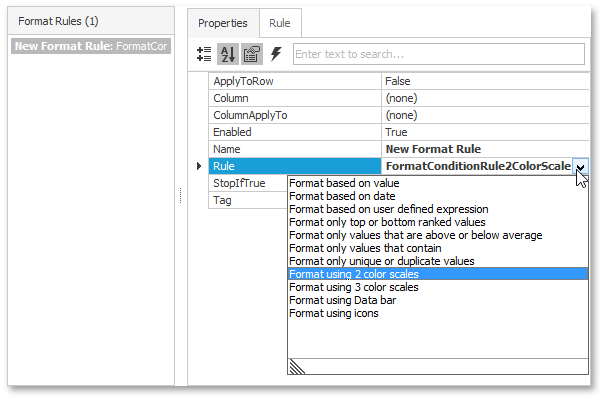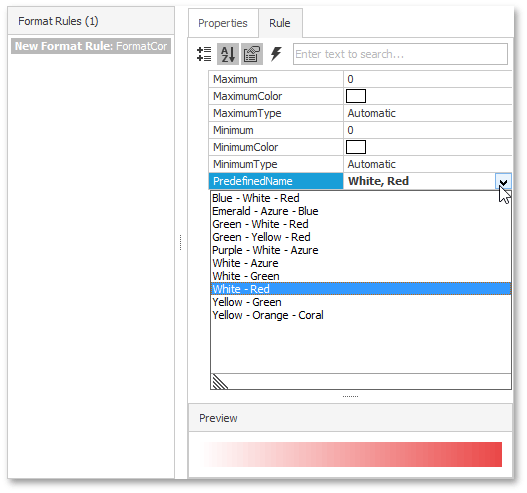FormatConditionRule2ColorScale Class
Applies a format using a two-color scale to display data distribution and variation.
Namespace: DevExpress.XtraEditors
Assembly: DevExpress.XtraEditors.v18.2.dll
Declaration
public class FormatConditionRule2ColorScale :
FormatConditionRuleMinMaxBase,
IFormatRuleAppearance,
IFormatConditionRule2ColorScale,
IFormatConditionRuleColorScaleBase,
IFormatConditionRuleBase,
IFormatConditionRuleMinMaxBaseRemarks
A FormatConditionRule2ColorScale object allows you to display data distribution and variation using a gradation of two colors. The shade of the color represents higher or lower values. For example, in a green and red color scale, you can specify that higher value cells have a more green color and lower value cells have a more red color.
By default, the FormatConditionRuleMinMaxBase.MinimumType and FormatConditionRuleMinMaxBase.MaximumType properties are set to Automatic, and thus, the minimum and maximum values in a column are calculated automatically. You can manually specify the values to regard as the minimum and maximum. To do this, set the MinimumType/MaximumType properties to Number or Percent and specify the values using the FormatConditionRuleMinMaxBase.Minimum and FormatConditionRuleMinMaxBase.Maximum properties.
You can apply a format using one of the predefined color scales. To do this, utilize the FormatConditionRule2ColorScale.PredefinedName property. You can additionally use the FormatConditionRule2ColorScale.MinimumColor or/and FormatConditionRule2ColorScale.MaximumColor properties (these properties, when set, override color settings specified by the FormatConditionRule2ColorScale.PredefinedName property).
The images below demonstrate examples of applying a FormatConditionRule2ColorScale format.


See the following documents to learn more.
- GridControl: Conditional Formatting.
- PivotGridControl: Conditional Formatting.
- TreeList: Conditional Formatting.
Example
This example illustrates how to apply a two-color scale format to the Unit Price column in a GridControl at design time using the Grid Designer and in code.

A two-color scale reflects data distribution of column cell values using a gradient of two colors. In this example, the predefined White - Red color scale is used. Cells with lower values will have a more white color and higher value cells will have a more red color.
To create a new formatting rule at design time, invoke the Format Rule Collection Editor from the Grid Designer. It can also be accessed from the Properties grid by clicking the ellipsis button for the ColumnView.FormatRules property.
Invoke the Grid Designer and switch to the Style Format Rules page (in the Appearance category).

- Click the Add button
 to create a new format rule (format rules in a GridControl are encapsulated by GridFormatRule objects).
to create a new format rule (format rules in a GridControl are encapsulated by GridFormatRule objects). Select the Format using 2 color scales rule type. The format rule’s FormatRuleBase.Rule property will be set to a new
FormatConditionRule2ColorScaleobject.
Set the GridFormatRule.Column property to the Unit Price column. This column provides values to test against the formatting rule.

By default, the format is applied to the same column. However, you can apply this format to another column by setting the GridFormatRule.ColumnApplyTo property. In addition, you can apply the format to the entire row by setting the GridFormatRule.ApplyToRow property to true.
Choose one of the predefined colors scales using the FormatConditionRule2ColorScale.PredefinedName property. You can do this in the Properties tab or the Rule tab. The Rule tab additionally allows you to see a preview of the selected color scale. In this example, the White - Red color scale is selected.

You can also provide a custom color scale using the FormatConditionRule2ColorScale.MinimumColor and FormatConditionRule2ColorScale.MaximumColor properties.
By default, the FormatConditionRuleMinMaxBase.MinimumType and FormatConditionRuleMinMaxBase.MaximumType properties are set to Automatic. This means that the minimum and maximum values for applying the format are calculated automatically. You can also specify values to regard as minimum and maximum using the FormatConditionRuleMinMaxBase.Minimum and FormatConditionRuleMinMaxBase.Maximum properties (the MinimumType/MaximumType properties should be set to Number or Percent).
Run the application. The image below illustrates the result.

The following code is equivalent to the design-time actions shown above.
using DevExpress.XtraEditors;
using DevExpress.XtraGrid;
GridFormatRule gridFormatRule = new GridFormatRule();
FormatConditionRule2ColorScale formatConditionRule2ColorScale = new FormatConditionRule2ColorScale();
gridFormatRule.Column = colUnitPrice;
formatConditionRule2ColorScale.PredefinedName = "White, Red";
gridFormatRule.Rule = formatConditionRule2ColorScale;
gridView1.FormatRules.Add(gridFormatRule);